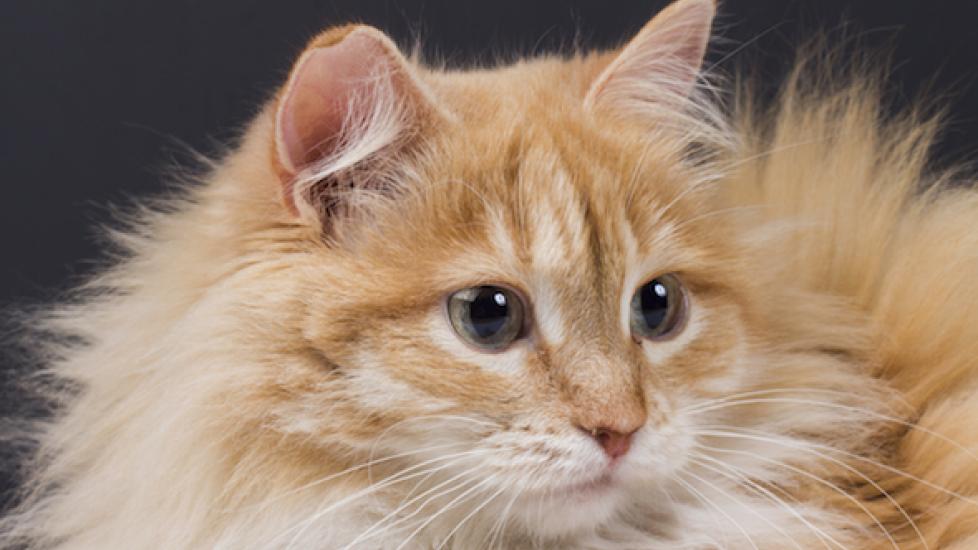Facts About Cat Dander and Allergies
By Vanessa Voltolina
Do you get sniffly, sneezy or itchy whenever your feline friend enters the room? These symptoms could, unfortunately, be signs of a cat allergy. Get all of the facts about cat dander, signs and symptoms of allergies, and how to make your home a more comfortable environment to coexist in with your furry friends, below.
What is Cat Dander?
When we say we have a cat allergy, many of us don’t know what’s actually happening in our bodies. It’s not our feline friends’ fur that causes allergies, it’s their dander—combined with urine and cat saliva—that’s the culprit behind your symptoms.
“Cats produce a protein known as Fel d 1,” said Dr. Rachel Barrack, DVM, of Animal Acupuncture. “This protein is contained in skin cells, urine and saliva, and triggers an allergic reaction. Dander is dead skin cells that are regularly sloughed off and replaced by new skin cells. All cats produce dander, but not all people are allergic to it.”
Vet Recommended Health Support
- Feliway Optimum Enhanced Calming 30 Day Diffuser for Cats$29.99Chewy Price
- Purina Pro Plan Veterinary Diets FortiFlora Powder Probiotic Digestive Supplement for Cats, 30 count$30.99Chewy Price
- Purina Pro Plan Veterinary Diets Hydra Care Liver Flavored Liquid Supplement for Cats, 3-oz pouch, case of 12$14.99Chewy Price
- Purina Pro Plan Adult Sensitive Skin & Stomach Lamb & Rice Formula Dry Cat Food, 7-lb bag$28.08Chewy Price
Signs and Symptoms of Cat Allergies
According to Bryan Martin, an osteopathic doctor and president of the American College of Allergy, Asthma and Immunology (ACAAI), cat allergy symptoms range from mild to severe, depending on an individual’s sensitivity and the level of exposure to allergens. Those variables may also influence how quickly symptoms develop after exposure. Highly sensitive people can develop symptoms within minutes of touching a cat or entering a feline-occupied house.
Like most allergies, cat allergies manifest in different ways for different people, Barrack said. For some, an allergy to cat dander can cause itchy, watery eyes, nasal congestion and coughing, while it may cause shortness of breath (similar to asthma), a skin rash or hives in others.
How to Treat Cat Allergies
If you suspect you may have allergies, begin by consulting an allergist. This will enable you to “obtain the most appropriate therapy to alleviate the associated symptoms,” Barrack said. Dust and pollen on a cat’s coat (rather than the cat’s dander itself) can cause allergies, according to the ACAAI, so receiving an allergy test can help determine whether your cat’s dander is the culprit or if it’s something else.
The allergist will likely recommend allergen testing and may pursue symptomatic treatment (such as antihistamines) to reduce discomfort or allergen immunotherapy shots to reduce the severity of reaction upon exposure to cat dander, Barrack said.
How to Combat Cat Dander
If you’ve been diagnosed with a cat allergy and have a cat, don’t fret. Just because an allergy has been diagnosed does not mean you need to get rid of your feline family member! There are methods for combatting cat dander in your home.
“Make sure to keep your cat well-groomed and brushed regularly to remove dander,” Barrack said. If your cat isn’t game for a DIY grooming session, bring him to a professional groomer. Besides making sure your feline is primped, it’s equally as important to keep up with home cleanliness. Barrack suggests trying to eliminate as much dust as possible (idea: reduce the number of “dust collectors” on your shelves) and vacuum pet hair regularly. “Home air filtration systems can also help decrease the amount of dander in one’s home,” she added.
Characteristics such as the length of a cat’s hair, gender and the amount of time a cat spends indoors are not associated with cat allergen levels, Martin says, so banishing your cat to the outdoors for a few hours daily or buying a cat with shorter hair may not be the best bet for combatting allergies. However, there is one aspect associated with allergen levels: number of cats. Homes with more than one cat have higher levels of cat allergens, he said.
What About “Hypoallergenic” Cats?
You may have heard that some cat breeds are hypoallergenic. However, the sad news is that there are no studies to support that cats can be hypoallergenic, as no domestic cat is completely free of dander. “Technically, there is no such thing as a hypoallergenic cat,” Barrack said. “All cats produce protein Fel d 1 and dander.”
That being said, she adds that there are some breeds known to produce less dander than others including Bengal, Burmese, Rex, Russian Blue, Siamese, Siberian, and Sphynx. And, of course, there are always measures to take to reduce the amount of dander in the home to make a more comfortable environment for you and your furry friend.
Image: Antonsov85 / Shutterstock




